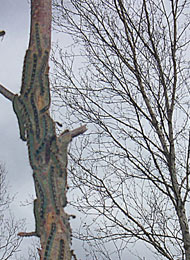Older stories on Resources News
Links to general resource, environmental sites
Links to non-profit environmental/resource groups
Links to environmental/resource news sources
E-mail Resources News
Lots of caterpillars
Forest tent caterpillars populations can be really dense.
In recent years, various areas of Canada have experienced heavy infestations of forest tent caterpillars. Predictions for this summer indicate that there will once again be lots of these pests around in some areas - in some cases covering not only trees, but buildings, vehicles, roads and anything else they can crawl on.
Just how heavy are these infestations? Very heavy. At the peak of a forest tent caterpillar outbreak, the biomass of caterpillars per square kilometre would be equivalent to 657 caribou. The biomass of the tiny parasitic flies that attack and feed on these caterpillars would be equivalent to 82 wolves in the same one square kilometre area. Given the immense scale of the predator-prey battle going in our backyards, parks, and forests, it isn't surprising that the forest tent caterpillar is the principal defoliating insect of trembling aspen in the boreal forests of Canada.
During a major outbreak," says , Dr. Jens Roland, Principal Investigator with the Sustainable Forest Management Network, "forest tent caterpillars can completely defoliate an aspen forest; virtually stop their growth - reducing growth increment by as much as four cubic metres of wood per hectare each year."
Research done by Dr. Roland established a link between the severity and length of forest tent caterpillar outbreaks and the size of the forest they are located in. His team of researchers sampled 127 sites covering an area of 400 square kilometres near Ministik Hills, Alberta, in aspen stands. The study sites ranged in size from as small as just over a quarter of a hectare to 289 hectares. The research also focused on four species of parasitic flies that are the main enemy of these caterpillars and various viral diseases that also kill forest tent caterpillars.
"What we determined," said Roland, "is that for the parasites and the viruses to be most effective, the size of the forest stand should be a minimum of about 100 hectares. Smaller forest stands served as a caterpillar refuge because of less effective natural enemies helping to extend the length of the infestation by several years."
